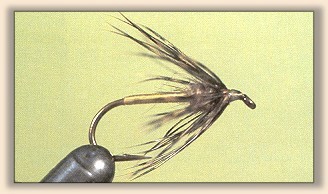Partridge and Yellow, Soft Hackle
By Skip Morris
Sylvester Nemes rediscovered an unusual fly and developed
some unusual methods for fishing it. In 1975 he revealed
these efforts to the fly-fishing world in his book The
Soft Hackled Fly. What he rediscovered is a simple,
bare-bones fly that looks exactly like nothing but suggests
a lot, and what it usually suggests are hatching mayflies,
caddisflies, and even stoneflies. "Soft hackles," as these
flies are often called, may be fished in a variety of manners,
just under the surface dead drift, twitched or swum (or, as
fly fishing author Dave Hughes described it to me "coaxed")
across the current, or even floated dead drift to imitate a
spent, bedraggled caddisfly (an approach from fly-fishing
artist Richard Bense).
The Partridge and Yellow Soft Hackle we will explore here is
only one of many variations - other body colors and materials,
other hackle colors and types, and even variations in hook styles
(light wire, heavy wire, various shank lengths) are used.
Materials List:
Hook: Dry fly, standard length, sizes 10 to 16.
Thread: Yellow (or simply a pale color), size 8/0 or 6/0.
Abdomen: Yellow single-strand floss.
Thorax: Hare's mask fur (a thorax is optional).
Hackle: Brown hen saddle hackle or partridge flank.
Tying Instructions:
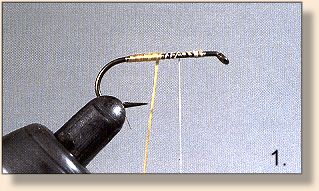
1. Tie in and wrap a floss body.
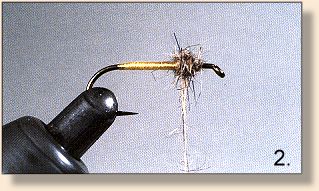
2. Dub a short, thick thorax (optional).
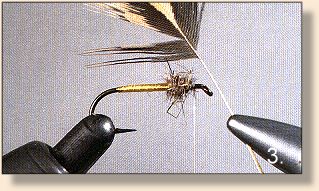
3. Select, measure, and prepare a hen saddle hackle.
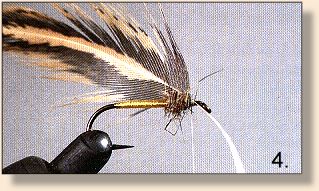
4. Tie in the hackle as shown, using a light turn.
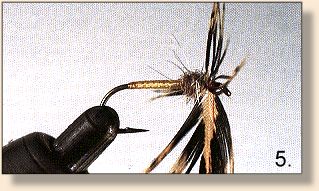
5. Wrap one turn of hackle.
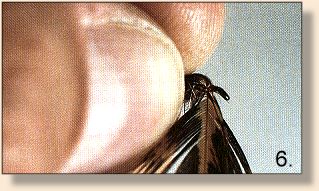
6. Draw back the fibers from the first turn of hackle;
then add a second turn; repeat this sequence for the third
and final turn.
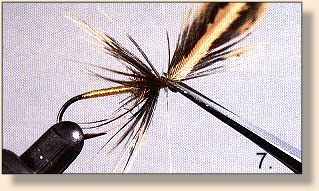
7. Tie off the hackle, trim its tip, and complete the
fly.
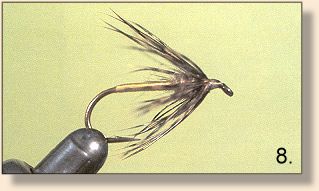
Hackling
...Hen saddle feathers are similar to partridge body feathers,
but partridge is smaller, less dense, and more difficult for
beginning tiers to handle, but it creates an excellent effect.
Hen saddle really is the best choice for your first soft hackle.
Switch to partridge later if you like, or just stick with the hen.
I think it also noteworthy that there seems to be considerable
disagreement concerning hackle-fiber length for soft-hackles - some
experienced tiers prefer that the fibers reach only to the rear
of the body; others like the fibers long. These instructions will
create a long-fibered soft hackle, but remember that you have options. . .
Problems, Solutions, And Suggestions
1. Many tiers prefer to draw the fibers back from the tip of the hackle
(hen or partridge body), tie the hackle in by its tip, and then wrap
the hackle by holding its butt. The tricky part is judging the fiber
length - starting too near the tip will require too many hackle turns
to reach the fibers of appropriate length, but starting too far down
the hackle will put the appropriate fibers onto the hook too soon.
Despite this, once you get used to just how long the fibers need to
be, this tip-first method will come quickly and easily.
2. Some of the keener anglers I know (Dave Hughes, Rick Hafele and
Richard Bunse in particular) are tying their soft hackle with sparser
hackles than before - let's face it, real caddisflies and mayflies
have only six legs. The best way to accomplish this is to strip
one side of the hen or partridge [feather], and then wind the
stripped feather in only two or three turns. ~ Skip Morris
Credits: Partridge and Yellow, Soft Hackle is
one of the many excellent instructional flies presented in
Skip Morris's book,
Fly Tying Made Clear and Simple, published by
Frank Amato Publications.
|

